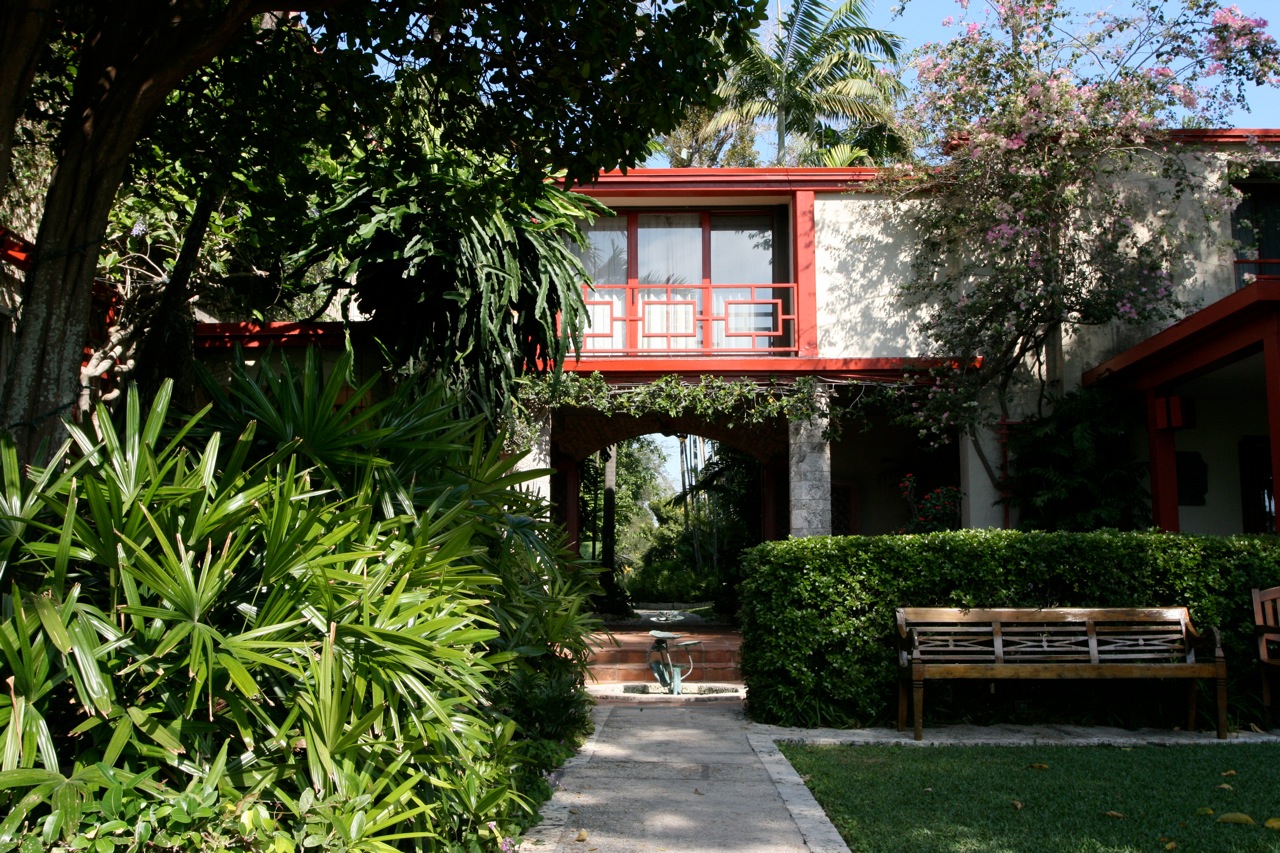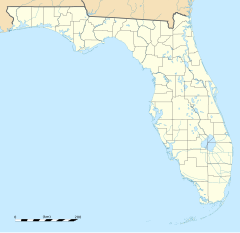| The Kampong | |
|---|---|
 |
|
| Type | Private |
| Location | Coconut Grove, Miami, Florida, United States |
| Area | 11 acres (45,000 m2) |
| Created | 1984 |
| Operated by | National Tropical Botanical Garden |
| Website | The Kampong |
|
The Kampong
|
|
 |
|
|
Original Fairchild home with Sweeney addition from courtyard
|
|
|
|
|
| Coordinates: | 25°42′53″N 80°14′59″W / 25.71472°N 80.24972°WCoordinates: 25°42′53″N 80°14′59″W / 25.71472°N 80.24972°W |
| Architect: | Edward Clarence Dean and Max Strang |
| Architectural style: | Mission/Spanish Revival |
| NRHP Reference#: | 84000837[1] |
| Added to NRHP: | March 1, 1984 |
The Kampong is an 11-acre (45,000 m²) tropical garden in the Coconut Grove neighborhood of Miami, Florida United States. It is one of the five gardens of the non-profit National Tropical Botanical Garden (NTBG), and is open to visitors. An admission fee is charged.
Contents |
History [link]
The Kampong was bought as their winter home by the famed horticulturalist Dr. David Fairchild and his wife Marian in 1916.[2] For many years he managed the Department of Plant Introduction program of the U.S. Department of Agriculture in Washington, D.C. whose purpose was to search the world for plants that could be useful and successfully introduced into the United States. In his life, Fairchild introduced around 30,000 different plant species and variations into the U.S. At his home in Florida, Fairchild created a garden that contained many of the plants that he obtained throughout his trips. In 1931 Marian's sister Elsie and her husband, Gilbert Grosvenor, acquired the adjoining property on the north to use as their winter home.[3] Fairchild and his wife made the Kampong their permanent home from 1928 until their deaths in 1954 and 1962 respectively.
A year after David Fairchild's wife's death, the land was purchased by Dr. Catherine Hauberg Sweeney, a botanist and preservationist.[4] Dr. Sweeney maintained Fairchild’s garden and was vital in its preservation for future use and study, securing its listing on the National Register of Historic Places. In 1984 Sweeney donated the property to the then Pacific Tropical Botanical Garden (now National Tropical Botanical Garden), and remained its principal sponsor until 1995. Director Larry Schokman curated and managed the garden until his retirement in 2008.
Facilities [link]
Today the Kampong's living collections include tropical fruits including pomelo, 23 cultivars of avocado, and 65 varieties of mango, palms, flowering trees, ficus, aroids, and bamboo.[5] This garden serves as the mainland campus for the NTBG. Major aspects of the Kampong include:
- The Fairchild-Sweeney House - designed by architect Edward Clarence Dean, constructed in 1928,[6] as a combination of Spanish and Southeast Asian influences. A later renovation to the home incorporated more modern features and added a second floor over a portion of the home, resulting in an unusual blend of styles. Visitors included Thomas Edison and Henry Ford.
- Schokman Education Center - designed by architect Max Strang, completed in 2007, as an outdoor pavilion incorporating oolitic limestone and exposed concrete. The roof of the new pavilion functions as a rainwater collection system and is connected to two 10,000 gallon underground tanks.[7]
- Mangrove preserve - one of the largest areas of salt-water mangrove forest in the area, containing all four mangroves native to the area, as well as Bruguieria gymnorhiza from the Philippines.
See also [link]
| Wikimedia Commons has media related to: The Kampong |
- Fairchild Tropical Botanic Garden
- National Tropical Botanical Garden
- McBryde Garden
- Allerton Garden
- Limahuli Garden and Preserve
- Kahanu Garden
- List of botanical gardens in the United States
References [link]
- ^ "National Register Information System". National Register of Historic Places. National Park Service. 2010-07-09. https://nrhp.focus.nps.gov/natreg/docs/All_Data.html.
- ^ Zuckerman, Bertram. The Kampong. (Coral Gables, FL): National Tropical Botanical Garden, 1993. p.11.
- ^ Zuckerman. p. 88.
- ^ Zuckerman. p. 139.
- ^ The Kampong of the National Tropical Botanical Garden (booklet), 2008,
- ^ Zuckerman. p. 85.
- ^ Shulman A, Miami Architecture, University Press of Florida, 2010, p. 141.
External links [link]
- The Kampong
- National Tropical Botanical Garden
- McBryde Garden
- Allerton Garden
- Limahuli Garden and Preserve
- Kahanu Garden
- Color Aerial Photo from Google Maps


